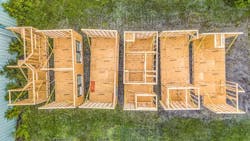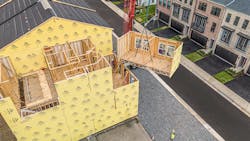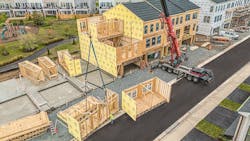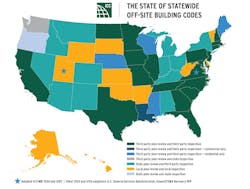Will Codes Move the Needle for Off-Site Construction?
This article first appeared in the September/October 2024 issue of Pro Builder.
Early in 2023, a coalition of home builders, housing industry organizations, and International Code Council (ICC) officials kicked off a campaign to introduce and pass legislation for modular construction codes in Utah.
At the time, the state was one of 11 across the U.S. that lacked statewide codes or standards governing off-site home construction. Instead, each municipality in Utah had authority over modular building, setting its own code requirements.
As such, builders and providers had to modify their designs for each jurisdiction, which quickly eroded the production efficiencies and cost savings of off-site methods compared with on-site stick-building.
“One of the biggest frustrations for off-site builders is the multitude of jurisdictional codes that are difficult for a factory to follow,” says Steve Dubin, business development manager for Rmax, a subsidiary of Sika, which supplies products to modular construction companies.
RELATED
- Home Builders, What's Your Off-Site Construction Super Power?
- Your Road Map to Off-Site Construction and Modular Homes
- Van Metre Unveils Modular Homes
That helps explain why only a small percentage of builders are apt to use off-site construction as a possible means to build faster and cheaper. In fact, just 3% of all single-family home completions in 2023 were modular or panelized, according to the U.S. Census Bureau.
Chris Gamvroulas, president of Ivory Development, a Utah production home builder, says the company recognized the potential value of modular construction, but with Utah’s hodgepodge of regulations, it didn’t make economic sense to move forward. However, if the codes could be harmonized statewide, that calculus could change.
An Uphill Battle for Off-Site Construction on Several Fronts
Before Utah’s modular code legislation drive started, some players in the state’s home construction ecosystem were wary of the concept. “The initial objections came primarily from local building officials,” Gamvroulas says. “They were concerned that mods wouldn’t be factory-inspected thoroughly and that cities would face liability as a result.”
The coalition for the statewide code wanted Utah to adopt ICC model codes 1200 and 1205, which guide off-site home construction. Among other things, these measures allow for third-party inspectors, paid by the builder, to scrutinize factory-built modules against a consistent set of standards.
Local building officials were concerned that independent inspectors paid by factory operators would have an incentive to ignore defects. But that’s “a misconception that’s been disproved in other states,” Gamvroulas points out.
Meanwhile, some legislators had the notion that modular was an inferior construction method, falsely interpreting the technology as “trailers” instead of something that, in reality, is far more similar to traditionally built homes.
The experience in Utah provides a viable template for the housing industry to drive the passage or modification of modular building codes in other states as well.
Reducing Resistance to Off-Site Construction
To break down the barriers confronting them, the Utah modular building code coalition launched an educational campaign to allay fears and misconceptions. It eventually succeeded, and the ICC standards were adopted as state law on March 19 this year.
Along the way, Ivory Innovations, a nonprofit organization created by Ivory Development to seek out and promote solutions for greater housing affordability, held a day-long conference at the University of Utah that focused on modular construction.
Local government code officials were invited to hear presentations about the processes, inspections, and insurance matters related to off-site construction methods presented by folks from the Modular Building Institute (MBI) and Autovol, an Idaho-based volumetric modular home builder, among others. “They pointed out that third-party inspectors have the same qualifications as local code officials,” Gamvroulas says.
Utah legislators, already less resistant to the proposal than the state’s building inspectors, attended factory tours of off-site operations that removed any lingering doubts. “They said, 'This is pretty cool. I don’t have worries about this at all,'” Gamvroulas recalls. And, in the end, Utah’s organization of state code officials didn’t block the legislation. “There was no opposition at all once the bill was proposed,” Gamvroulas says.
Other states, such as Virginia, already had statewide home inspection programs for off-site construction operations in place before adopting the ICC codes. And, even if a state has an active program, adding the ICC standards is a worthwhile pursuit, according to Christopher Fox, VP of architecture and building science at Van Metre Companies, a Virginia-based home builder with an extensive off-site operation serving its production needs. “State codes based on ICC guidelines give comfort to local code officials who have the ultimate authority on home inspections,” he says.
Matt Belcher, principal and COO of Enhanced Buildings, in St. Louis, agrees. “They give local code officials some metrics to go by,” he says, plus confidence that state inspections at the factory are guided by widely accepted ICC standards.
A stamp that certifies a successful factory inspection also gives local code officials a sense of ease as they complete the work of inspecting the home on site, Fox adds.
Of course, local officials retain final authority over building inspections and approvals and aren’t legally bound to certify factory-built home components that have passed state inspection, which is why off-site builders will at times tailor designs and production for certain jurisdictions.
For example, Fox says Van Metre alters the walls of its modular cassettes to assure one particular county inspector that the panels not only comply with the county’s fire-rating requirements but also can be inspected to ensure no damage was sustained during transport to the jobsite. Inspectors in other counties haven’t expressed such concerns, Fox adds.
Do We Really Need More Regulation?
While the potential for more oversight may rankle home builders already stressed by regulatory rules and associated costs, achieving harmony among the codes governing modular home production will ultimately make it easier for off-site providers and in-house operations such as Van Metre to optimize economies of scale. “If all of the codes were the same everywhere, you could build the same product in each state,” Fox says.
Of course, accounting for different climate zones and specific needs in areas prone to natural disasters, such as hurricanes along the Gulf and eastern coastlines, will always be necessary and will work against modular’s cost efficiencies ... just as they do for stick-built homes. But on a broader scale, statewide codes hold the promise to significantly mitigate most design and production changes required by local jurisdictions, making it more cost- and time-efficient to produce homes in a factory.
Standardized codes such as ICC 1200 and 1205 reinforce that argument by offering codified best practices on regulating off-site production quality and consistency, says Ryan Colker, VP of innovation and the executive director of the Alliance for National & Community Resilience at the ICC.
Specifically, the 1200 standard is concerned with design, fabrication, and assembly, while 1205 outlines how to implement and operate state inspection programs using third-party certification.
“Those standards capture best practices from across the country and internationally,” Colker says. They also are kept current through centralized updates, he adds, which are then applied to state laws.
Momentum is building for more states to adopt ICC 1200 and 1205. “I expect to see a pretty big uptake over the next couple of years,” Colker says. And, Jon Hannah-Spacagna, MBI’s government affairs director adds, “If adopted, the industry will have the ability to move more quickly to alleviate the housing crisis.”
Off-Site Methods Are Finally Seeing Growing Support
Awareness of and support for off-site construction are increasing throughout the housing industry, Hannah-Spacagna says.
For example, the Federal Emergency Management Administration plans to use modular construction to rebuild communities that have been decimated by natural disasters. Recently the agency released a request for proposal to provide 2,000 modular housing units to replace homes destroyed by a devastating wildfire in and near Lahaina Town on Maui, Hawaii, in August last year.
The houses likely won’t be fabricated in Hawaii but will be built to the 2018 International Building Code (which the state currently uses), and will be approved through ICC 1200 and 1205 standards.
Advances in related technologies may also spur adoption of off-site methods.
Artificial intelligence offers a potentially promising way to make coping with multiple codes easier, says Sneha Kumari, the co-founder and CEO of Merlin AI, an enterprise resource planning software platform targeting off-site construction.
Using a natural language interface for AI, “A factory manager doesn’t need special training or a software consultant to adjust production equipment settings to fabricate panels and modules for different code requirements,” she says.
With variation in code requirements, ease of use in design and production technology is critical for off-site production to fulfill its potential. “Repeatability is going to be key to making the most of the product and unlocking efficiency,” Kumari says. That fact drives builders and their trade organizations to continue to seek harmonized codes for modular construction.
“In a perfect world, states could create a code that a county couldn’t override,” Fox says. And while that outcome is unlikely to happen anytime soon, “it’s not stopping us from using industrial methods of construction,” he adds.







